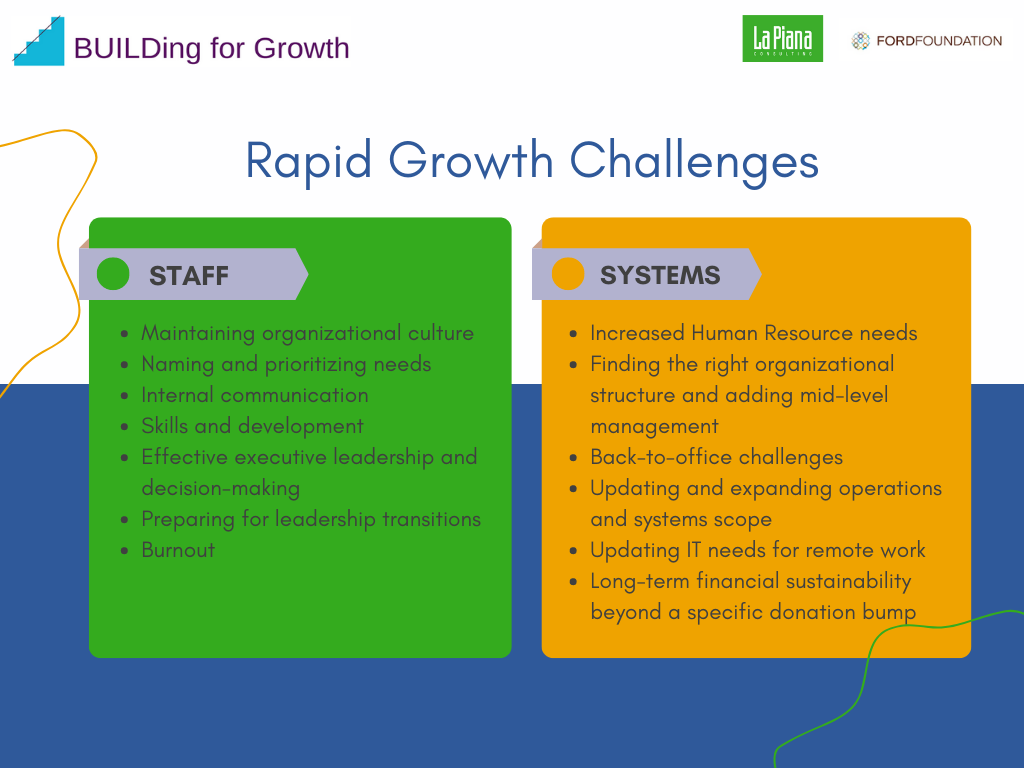What We Learned from 50 Nonprofits Navigating Rapid Growth
Read our 6 key insights from organizations in the midst of rapid growth. These highlights are from a report on our BUILDing for Growth program, developed in partnership with the Ford Foundation.
In recent years, nonprofits across the sector have experienced unprecedented and, in many cases, unexpected growth. A surge in individual giving fueled by large, one-time gifts from philanthropists like MacKenzie Scott, a growing attention to social justice movements, and an increasingly divisive political climate have resulted in record-breaking donations to the social sector.
La Piana Consulting interviewed over 50 nonprofits across the U.S. that are in the midst of rapid growth, and, in the process, we identified several critical challenges associated with this experience (see graphic below).

In collaboration with the Ford Foundation’s BUILD initiative, La Piana developed an evidence-based intervention to tackle these challenges. BUILDing for Growth is a customized, capacity-building program that helps select Ford grantees navigate substantial, rapid, and unplanned growth, all while developing the organizational infrastructure needed to drive sustainable impact. In over a year spent with these nonprofits – engaging in Communities of Practice, workshops, and one-on-one consulting to unpack these rapid growth challenges – we learned 6 key principles:
- Rapid growth is a unique challenge. Nonprofits in the thick of this experience face issues that are both specific to and magnified by growth, so navigating this situation alongside others experiencing rapid growth is invaluable to organizational reflection and transformation.
- Rapid growth disproportionately impacts human resources and operations functions. Yet, response to these areas of need often lags behind other departments. Human resources and operations require particular attention and investment, so organizations can be deliberate, strategic, and responsive to the needs of a growing team.
- Flexibility and clarity help staff during periods of rapid growth. Nonprofit staff across the sector are demanding transparency in decision making, new management structures, and a response to high levels of burnout. Leaders must foster clear, consistent communication with staff about the many changes that will occur during growth and how staff will be affected.
- Despite a large influx of funding, sustainability must be prioritized. Many leaders we interviewed were concerned about future funding, because they saw increased donations as a response to the current news cycle. Amidst rapid growth, nonprofits must set aside resources and create development plans that will maintain sustainability when growth slows or stops.
- Pause and examine internal strengths, infrastructure, and organizational capacity before making big changes. Many organizations we interviewed addressed rapid growth successfully by turning part of their efforts inward – focusing on internal capacity building, strengthening infrastructure, evaluating and leveraging activities for increased impact, and even pausing service delivery to tackle key internal challenges. Though the impulse may be to keep growing and building on current work, making purposeful time to reflect, plan, and retool is a real asset.
- Culture must both change and stay the same. Growth impacts organizational culture, so leaders must find balance between maintaining current culture and adapting to new staff and an evolving social landscape. Successful nonprofits created space for existing and new staff to refine their culture collaboratively with strong support from leadership.
Click here to read the full report of our findings from the BUILDing for Growth program!


Comment section